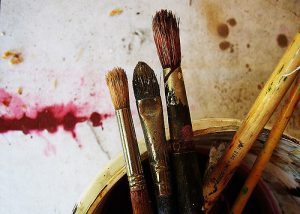A Beneficial Match: Expressive Art Therapy And Eating Disorders
 “Art heals because of the way people react to the artistic process and to the images produced,” writes Lisa Hinz in her book Drawing from Within: Using Art to Treat Eating Disorders.
“Art heals because of the way people react to the artistic process and to the images produced,” writes Lisa Hinz in her book Drawing from Within: Using Art to Treat Eating Disorders.
The healing power of art is especially helpful with eating disorders since people with them tend to protect themselves with rationalization, intellectualization, and arguments that leave little room for self-compassion and new insight.
Art bypasses language, however. It takes individuals’ awareness beyond their usual talking points to where perspectives can shift, allowing people to see themselves anew.
Expressive art therapy facilitates this self-understanding in several ways:
- Hidden Strengths Revealed. The challenge of expressing one’s self with various art media can spotlight a person’s forgotten strengths. For instance, hidden reservoirs of perseverance, determination, and resilience may be drawn upon during artistic endeavor.
- Recovering Wholeness. When creating, the unconscious mind of the artist speaks to the conscious mind of the artist. In this way, the images formed communicate much the way images in dreams do—by bringing hidden aspects of our wholeness back into everyday awareness.
- Saves Time. Issues tend to emerge more quickly through artistic creation than by speaking alone, and sometimes things difficult to say are more easily represented by a picture. Metaphoric images can incorporate chaotic, conflicting, or ambivalent thoughts and feelings, making sense of them in ways words may not.
- Therapeutic Record. The artwork individuals create during therapy stands as a record of their recovery efforts, and a testament to their innate wisdom. The images can also be used later for continued contemplation, or might be altered to reflect changing feelings, perceptions, or behaviors.
Many people with eating disorders have become disconnected from their own voice. Painting, drawing, or sculpting can sometimes reintroduce them to their authentic self because the person, not the disorder, is in charge of the creation.
Source: Hinz, Lisa, D., Drawing from Within: Using Art to Treat Eating Disorders; Jessica Kingsley, London; 2006, pages 9-17.
Photo credit: Celine Nadeau
 Eating Disorder Self Test. Take the EAT-26 self test to see if you might have eating disorder symptoms that might require professional evaluation. All answers are confidential.
Eating Disorder Self Test. Take the EAT-26 self test to see if you might have eating disorder symptoms that might require professional evaluation. All answers are confidential.